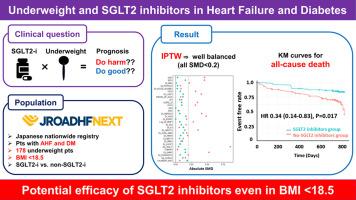Association between sodium-glucose Co-transporter-2 inhibitor use and prognosis in underweight patients with diabetes mellitus and heart failure
IF 2.6
Q3 NUTRITION & DIETETICS
引用次数: 0
Abstract
Background & aims
It remains unclear whether sodium-glucose co-transporter-2 (SGLT2) inhibitors are effective for patients with underweight. This study aimed to elucidate the association between SGLT2 inhibitors use and prognosis in underweight patients with diabetes mellitus (DM) and HF.
Methods
This study was a post-hoc analysis of data from the Japanese Registry of Acute Decompensated Heart Failure, a prospective, multicenter, observational, nationwide registry. All hospitalized patients with HF decompensation requiring treatment were assessed for eligibility between April 2019 and April 2021. Patients with DM and body mass index (BMI) < 18.5 kg/m2 at discharge without a history of dialysis were included in this study. The patients were categorized into two groups based on SGLT2 inhibitor use at discharge. The main analysis relied on inverse probability of treatment weighting (IPTW) to balance the differences between the two groups, and the primary endpoint was 2-year all-cause mortality.
Results
Of the 4016 patients registered from 87 hospitals, 178 underweight patients with HF and DM (mean age: 77 years, 57 % men, and mean BMI: 16.9 kg/m2) were analyzed. Of them, 59 patients were on SGLT2 inhibitors at discharge while 119 patients were not. Compared with the patients in non-SGLT2 inhibitor group, those in SGLT2 inhibitor group were younger, more often men, and had a lower left ventricular ejection fraction and higher albumin levels. After IPTW, the patient characteristics were well balanced with all the standardized mean difference <0.2. Kaplan–Meier curves showed that the SGLT2 inhibitor group had a significantly lower incidence of mortality than the non-SGLT2 inhibitor group (14.7 % versus 33.3 %), which was mainly driven by the difference in cardiovascular death (6.4 % versus 18.8 %). The association between SGLT2 inhibitor use and lower mortality was maintained even after IPTW with additional regression adjustment (hazard ratio, 0.40; 95 % confidence interval 0.17–0.93; P = 0.033).
Conclusions
SGLT2 inhibitor use is associated with lower mortality in underweight patients with DM and HF.

钠-葡萄糖共转运蛋白-2抑制剂在体重过轻的糖尿病和心力衰竭患者中的应用与预后的关系
背景与目的:钠-葡萄糖共转运蛋白-2 (SGLT2)抑制剂对体重过轻患者是否有效尚不清楚。本研究旨在阐明体重不足合并糖尿病(DM)和心衰患者使用SGLT2抑制剂与预后之间的关系。方法:本研究对日本急性失代偿性心力衰竭登记处的数据进行事后分析,这是一项前瞻性、多中心、观察性的全国性登记处。在2019年4月至2021年4月期间对所有需要治疗的HF失代偿住院患者进行资格评估。本研究纳入了出院时无透析史的糖尿病和体重指数(BMI)为2的患者。根据出院时SGLT2抑制剂的使用情况将患者分为两组。主要分析依靠治疗加权逆概率(IPTW)来平衡两组之间的差异,主要终点是2年全因死亡率。结果:在87家医院登记的4016例患者中,分析了178例体重不足的HF和DM患者(平均年龄:77岁,57%为男性,平均BMI: 16.9 kg/m2)。其中,59例患者在出院时使用SGLT2抑制剂,119例患者未使用。与非SGLT2抑制剂组相比,SGLT2抑制剂组患者更年轻,多为男性,左室射血分数较低,白蛋白水平较高。IPTW后,患者特征与所有标准化平均差异很好地平衡。结论:体重过轻的糖尿病和心衰患者使用SGLT2抑制剂与较低的死亡率相关。
本文章由计算机程序翻译,如有差异,请以英文原文为准。
求助全文
约1分钟内获得全文
求助全文
来源期刊

Clinical nutrition ESPEN
NUTRITION & DIETETICS-
CiteScore
4.90
自引率
3.30%
发文量
512
期刊介绍:
Clinical Nutrition ESPEN is an electronic-only journal and is an official publication of the European Society for Clinical Nutrition and Metabolism (ESPEN). Nutrition and nutritional care have gained wide clinical and scientific interest during the past decades. The increasing knowledge of metabolic disturbances and nutritional assessment in chronic and acute diseases has stimulated rapid advances in design, development and clinical application of nutritional support. The aims of ESPEN are to encourage the rapid diffusion of knowledge and its application in the field of clinical nutrition and metabolism. Published bimonthly, Clinical Nutrition ESPEN focuses on publishing articles on the relationship between nutrition and disease in the setting of basic science and clinical practice. Clinical Nutrition ESPEN is available to all members of ESPEN and to all subscribers of Clinical Nutrition.
 求助内容:
求助内容: 应助结果提醒方式:
应助结果提醒方式:


